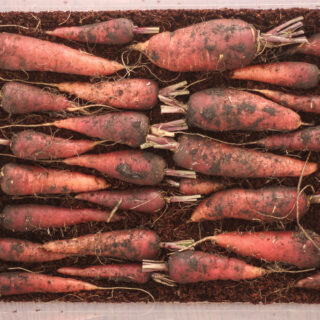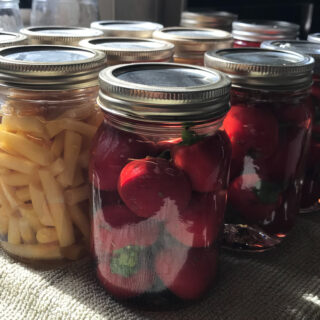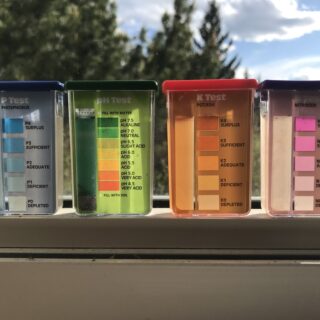 Steve and I have always dreamed of making our own charcuterie and salumi. We’ve made fresh sausages a few times with really great results but have always wished we had a close Italian friend who would share their secrets to homemade cured meats like chorizo, capicollo and prosciutto.
Steve and I have always dreamed of making our own charcuterie and salumi. We’ve made fresh sausages a few times with really great results but have always wished we had a close Italian friend who would share their secrets to homemade cured meats like chorizo, capicollo and prosciutto.
To me there is something highly romantic about a cellar full of carefully prepared cured meats, made with love and shared with friends (or alone with a glass of red wine!). It seems mysterious and complex, on the edge of dangerous.
Actually it is sorta on the edge of dangerous. Even though people have been preserving and curing meats at home for generations it is a very concrete reality that you can do it wrong and make yourself, or someone else, really sick. Can you say botulism? This potential should not be taken lightly IMO.
Because of this I have always been reluctant to give charcuterie a try without some sort of mentor. There are lots of videos on youtube that make it look pretty easy, but I find that many of them are incomplete, particularly lacking in information about curing temperatures, humidity and how to know if something goes wrong. (I did enjoy a funny one where the guy’s nona used a snowblower to flatten her soppressata though)
On one of my many little forays through the web I found a product that intrigued me though, a glimmer of hope that I really could do this. UmaiDry is an easy to use sealing bag. You know, like the ones used with a Foodsaver, that creates a breathable barrier for cured meats and allows you to cure them in your refrigerator. Now that I could wrap my head around. Curing meat within the safe(er) confines of my nice chilly fridge!
First problem, no Foodsaver. Solution – throw cash. As I get older more mature that is my solution for a lot of stuff.
After ordering a few of the UmaiDry charcuterie kits, we were away to the races. Our first lomo, a cured lean pork loin, was a success. The only problem was that we ate or gave it all away so quickly that it was gone in a flash, and we had not prepared ourselves by starting a new one while the first was curing in order to have some always on the go. Note to self…
Currently, I have 3 large portions of pork loin as well as a pork butt for capicollo curing sitting in it’s salt cure, waiting to go on to the drying stage. But, it will be weeks before that is done and I am impatient.
Solution; duck breasts.
Duck breast, I learned, is used by the french to create a cured meat called Magret de Canard Séché. Because duck breasts are so small, they cure and dry very quickly and are an easy cured meat to prepare, with or without UmaiDry. From what I am gathering Magret is a particular breed of bird which I do not have access to but, despite my ever-so-slight weirdness over the fact that this will essentially be raw poultry, I purchased two free range duck breasts from my favourite farm stand and set to work. I’m not sure if this dish would be named differently if it isn’t magret but the french name sounds so lovely that I am sticking with it.
 First step was to trim off any excess fat and skin from the duck breasts
First step was to trim off any excess fat and skin from the duck breasts
 and then to score the skin side so that the salt, cure and spices can reach both sides of the meat.
and then to score the skin side so that the salt, cure and spices can reach both sides of the meat.
Though traditionally only salt was used to cure, more modern food safety methods suggest that a small amount of nitrate should also be used. As the meat cures the nitrate turns into nitrite offering a longer curing power. Because a duck breast is so small, these only need to be cured for about 7 days in the fridge.
 Then, using the UmaiDry (this is not a sponsored post BTW, I’m just excited about this product) charcuterie bags and my fancy-dancy Foodsaver, the breasts were rinsed, sealed and then set onto a wire rack in the fridge until they’ve lost about 35-40% of their weight.
Then, using the UmaiDry (this is not a sponsored post BTW, I’m just excited about this product) charcuterie bags and my fancy-dancy Foodsaver, the breasts were rinsed, sealed and then set onto a wire rack in the fridge until they’ve lost about 35-40% of their weight.
That took a bit longer than I expected but today was the day. Ready at last!
 There is a good video which includes the ingredients and instructions here. If you decide to give this product a go all of the instructions and some of the ingredients come with the kit. (I will likely try a more traditional version soon and I’ll give detailed instructions if that one works out this well)
There is a good video which includes the ingredients and instructions here. If you decide to give this product a go all of the instructions and some of the ingredients come with the kit. (I will likely try a more traditional version soon and I’ll give detailed instructions if that one works out this well)
The prosciutto is lovely. It has a beautiful rich colour and the flavour is wonderful. It would be a treat on any charcuterie board . You can see that the meat is dry on the outside but it is not leathery at all, just shiny from the sealing bag. The inside is nice and tender just as you would expect.
I am loving making my own cured meats. I do think I’m gonna need a new meat slicer though, as mine is not of high enough quality to get that super thin slice that I am looking for. For now a really sharp knife is going to have to do.





